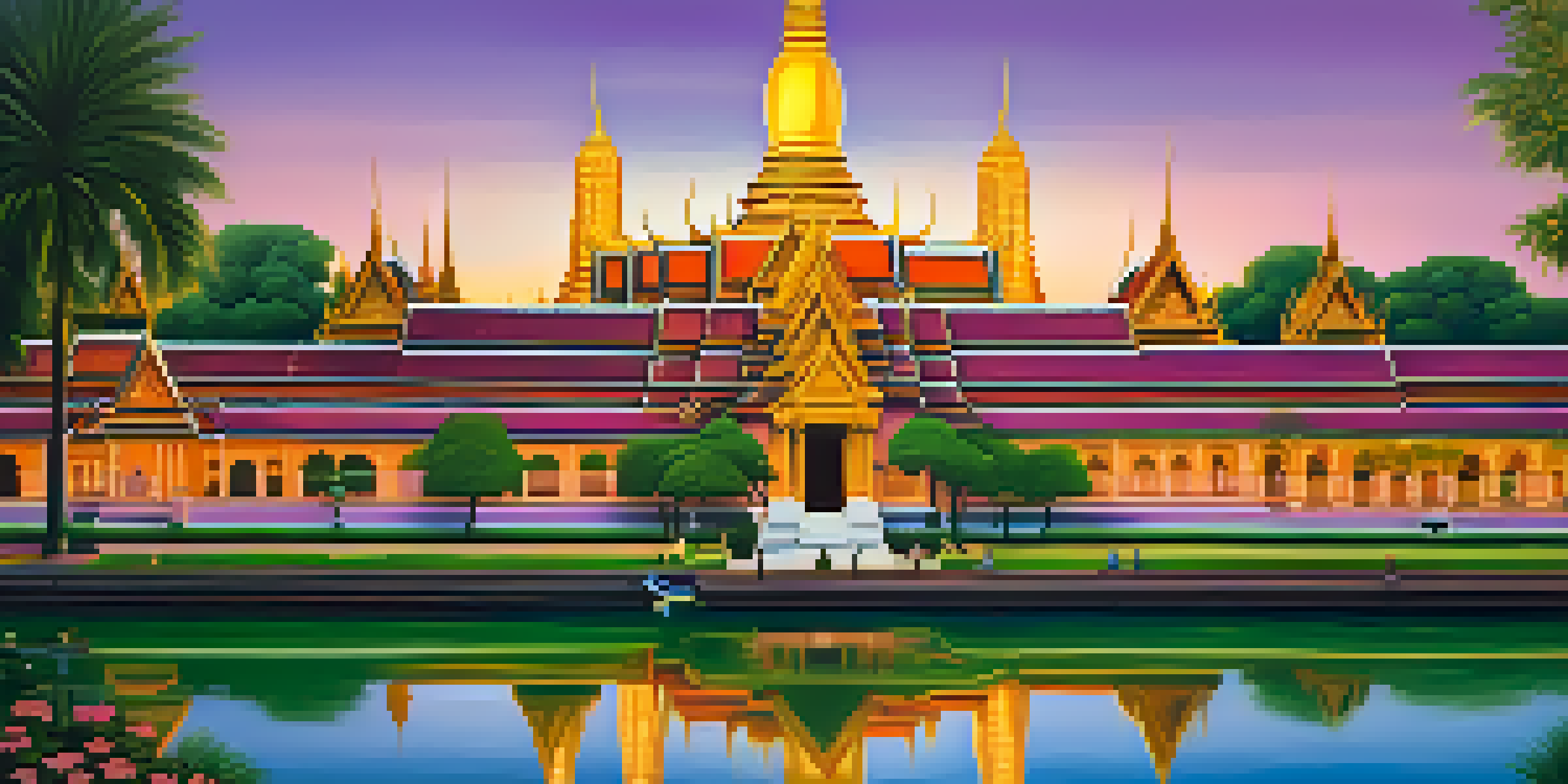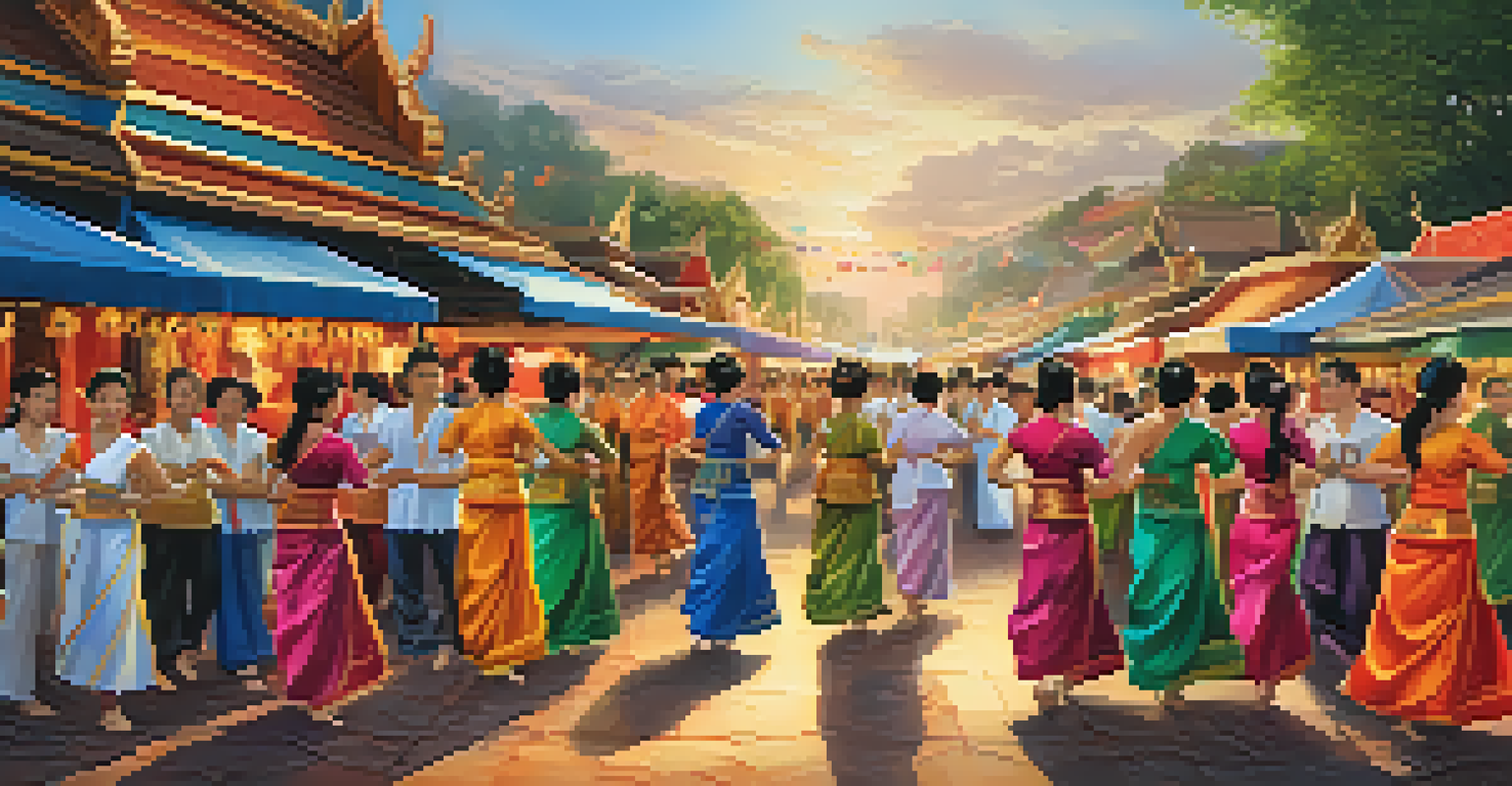Rattanakosin: The Modernization of the Thai Kingdom

The Birth of Rattanakosin: A New Era Begins
The Rattanakosin era began in 1782 when King Rama I established Bangkok as the capital of Thailand. This marked a significant departure from the previous Ayutthaya kingdom, which had fallen to Burmese invaders. The establishment of a new capital was not just a geographical shift, but a symbolic rebirth of the Thai kingdom.
The past cannot be changed. The future is yet in your power.
With the new capital, King Rama I aimed to consolidate power and revive Thai culture. He initiated the construction of grand temples and palaces, including the famous Wat Phra Kaew, which houses the Emerald Buddha. This period saw a renaissance of arts, literature, and architecture, which shaped the cultural landscape of Thailand.
Additionally, Rattanakosin's establishment set the stage for future kings to modernize the kingdom further. This era laid the foundations for a national identity that blends tradition with progressive values, creating a unique Thai cultural narrative.
Rama IV and the First Steps Toward Modernization
King Rama IV, also known as King Mongkut, ascended the throne in 1851 and was a pivotal figure in Thailand’s modernization. He recognized the need for reform to protect the kingdom from colonial powers encroaching on Southeast Asia. This realization led him to adopt Western scientific methods and education systems, which were revolutionary for the time.

Under his reign, Rama IV invited Western experts to help improve various sectors, including agriculture and public health. His efforts laid the groundwork for modern Thai governance and infrastructure, emphasizing the importance of education and scientific progress. This was a remarkable shift from the traditional ways of the past.
Rattanakosin: Birth of Modern Thailand
The establishment of Bangkok as the capital in 1782 marked the beginning of a new era that blended tradition with modernization in Thailand.
Moreover, King Mongkut's diplomatic maneuvers, including treaties with Western nations, showcased his vision for a sovereign, modern Thailand. His reign exemplified the delicate balance between preserving Thai culture and embracing necessary changes to thrive in a rapidly evolving world.
Rama V: The Architect of Comprehensive Reforms
Following in his father's footsteps, King Rama V, or King Chulalongkorn, took the modernization efforts even further. Ascending the throne in 1868, he implemented a series of reforms that transformed Thai society. These reforms included the abolition of slavery and the establishment of a modern legal system, which were groundbreaking changes for the time.
Education is the most powerful weapon which you can use to change the world.
Rama V also focused on improving education, establishing schools and universities that provided a Western-style curriculum. This emphasis on education fostered a new generation of educated Thais who would go on to play significant roles in the nation’s development. His vision was to create a knowledgeable populace capable of contributing to a modern state.
Additionally, King Chulalongkorn's efforts in public health and infrastructure, such as railroads and telecommunication, connected the kingdom in unprecedented ways. His reign is often viewed as a golden age of reform that set Thailand on a path toward becoming a modern nation-state.
Cultural Renaissance: The Arts in Rattanakosin
The Rattanakosin era witnessed a vibrant cultural renaissance that significantly influenced Thai arts and literature. Traditional forms of expression flourished alongside Western styles, creating a unique blend that defined the period. This artistic fusion can be seen in the architecture of the Grand Palace, where traditional Thai designs meet Western influences.
Literature also thrived during this time, with notable authors emerging who wrote in both Thai and Western styles. Their works often reflected the societal changes and modernization efforts, capturing the spirit of a nation in transition. This literary movement helped to foster a sense of national identity among the Thai people.
Education: Key to National Progress
The focus on education during the reigns of Kings Rama IV and V transformed Thailand into a literate and skilled society, essential for competing globally.
Moreover, the era’s cultural advancements were not limited to the arts; they also included music and dance, which became more formalized and structured. Festivals and public performances became popular, further enriching the cultural tapestry of the kingdom and enhancing its social cohesion.
Thailand's Position in a Changing World
As modernization progressed, Thailand found itself navigating a rapidly changing global landscape. The late 19th and early 20th centuries saw the rise of imperialism, with Western powers aggressively expanding their influence in Asia. Thailand, however, managed to maintain its sovereignty through diplomacy and strategic reforms.
King Rama V’s and his successors’ foreign policies were instrumental in this regard. By skillfully negotiating treaties and engaging with Western nations, Thailand avoided colonization while modernizing its institutions. This unique position helped Thailand to emerge as a distinct nation-state among its neighbors.
Additionally, the modernization efforts not only improved domestic conditions but also positioned Thailand as a key player in regional politics. The ability to adapt and modernize while maintaining cultural identity has been a defining characteristic of Thailand's historical narrative.
The Role of Education in Modernization
Education played a crucial role in the modernization of the Thai kingdom, transforming it from a feudal society to a modern nation-state. The establishment of formal education systems under King Rama IV and King Rama V laid the groundwork for a literate and skilled populace. This emphasis on education was essential for the kingdom to compete in a globalized world.
Schools and universities were founded, providing access to knowledge that empowered individuals and fostered innovation. The curriculum expanded to include science, mathematics, and foreign languages, reflecting the growing importance of a modern education. This shift not only improved literacy rates but also encouraged critical thinking among the Thai people.
Cultural Legacy Endures Today
The Rattanakosin era's blend of tradition and progress continues to influence Thailand's national identity and development in the modern world.
As a result, educated Thais began to take on prominent roles in government, business, and academia. This new class of educated citizens played a vital role in shaping the future of Thailand, ensuring that the country could navigate the challenges of modernization while preserving its unique cultural identity.
Legacy of Rattanakosin: Impact on Modern Thailand
The Rattanakosin era has left a lasting legacy that continues to influence modern Thailand. The foundations laid during this period in governance, education, and culture have shaped the nation's identity and development. Many of the institutions and practices established during this time remain integral to Thailand's societal framework today.
Moreover, the successful navigation of modernization without losing cultural identity has become a model for other nations. Thailand's ability to blend tradition with progress is often celebrated as a hallmark of its national character. This duality has fostered a sense of pride and resilience among the Thai people.

In contemporary Thailand, the lessons learned from the Rattanakosin era resonate in ongoing discussions about national identity and modernization. As the country continues to evolve in the global arena, the spirit of Rattanakosin serves as a reminder of the importance of adaptability, cultural preservation, and national unity.